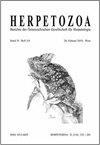New survey data on abundance and movements for two poorly known Asian Spiny Frogs
IF 0.9
4区 生物学
Q3 ZOOLOGY
引用次数: 0
Abstract
We present new natural history data on abundance and movements (daily and seasonal) during the pre-breeding (March-June) and breeding-post-breeding season (July-September) of two poorly studied frog species of the Himalayas, Nanorana vicina and Allopaa hazarensis. We estimated 185 Murree Hills Frogs and 90 Hazara Frogs within the study area (0.79 ha). The daily and seasonal movement data showed that the two species moved either between neighboring ponds or remained in an array of smaller ponds (within an area of 120 m2) along the stream bank. About 75% of movements were < 29.5 m in N. vicina and < 50.87 m in A. hazarensis during pre-breeding season while < 41.5 m in N. vicina and < 81 m in A. hazarensis during breeding-post-breeding season. We suggest inclusion of amphibian habitat requirements and ensuring stream connectivity in urban planning and development projects in the area to prevent the local extinction of the endemic species. In the future, more robust and long-term studies, encompassing more streams situated within a wider area, would help clarify dispersal, colonization, metapopulation structure, and dynamics of these endemic frogs of the forested montane streams in the Himalayan Foothills.两种鲜为人知的亚洲棘蛙数量和活动的新调查数据
我们提供了关于喜马拉雅山脉两种研究不足的蛙类Nanorana vicina和Allopaa hazarensis在繁殖前(3-6月)和繁殖后(7-9月)的丰度和运动(每日和季节性)的新的自然历史数据。我们估计研究区域(0.79公顷)内有185只Murree Hills蛙和90只Hazara蛙。每日和季节移动数据显示,这两个物种要么在相邻的池塘之间移动,要么留在河岸的一排较小的池塘中(面积为120平方米)。在繁殖前季节,约75%的移动在N.vicina中<29.5米,在A.hazarensis中<50.87米,而在繁殖后季节,在N.vicino中<41.5米,在A.hazarensi斯中<81米。我们建议在该地区的城市规划和发展项目中纳入两栖动物栖息地要求,并确保溪流连通性,以防止当地特有物种的灭绝。未来,更有力和长期的研究,包括位于更大区域内的更多溪流,将有助于澄清喜马拉雅山麓森林山地溪流中这些特有蛙类的扩散、定殖、集合种群结构和动态。
本文章由计算机程序翻译,如有差异,请以英文原文为准。
求助全文
约1分钟内获得全文
求助全文

 求助内容:
求助内容: 应助结果提醒方式:
应助结果提醒方式:


